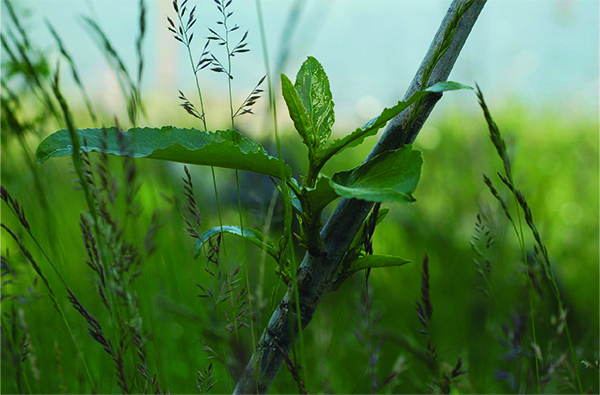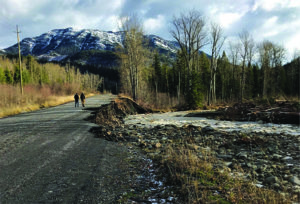Home »

Flood mitigation and wild habitat restoration work underway
Cottonwoods are beautiful deciduous trees native to North America, well known for releasing fluffy seeds that fall like snowflakes in the early summer. They provide shade for animals, stabilize river banks, slow down floodwaters, and form the basis of valley floor food-webs. Unfortunately, land-use such as urban development, agriculture, and infrastructure often competes for space with cottonwood forests.
To address the loss of floodplain forest, the Elk River Alliance is starting an ecosystem-scale cottonwood assessment and restoration project in the Elk Valley.
Over the next few years, ERA will survey the current status of cottonwood forests, determine priority areas, and plant native plants and cottonwood “live-stakes” (living branches that will grow into full trees). Restoration work will focus on the floodplain and stream-side areas of the Elk River and its tributaries. The project will also include community education on the value of a healthy cottonwood forest and landowner collaboration to explore restoration options.
Cottonwoods improve terrestrial and aquatic wildlife habitat
Cottonwood branches form a dense canopy that provides shade for wildlife during the summer heat. The understory brush of cottonwood stands is a perfect habitat for elk, bears, birds, and many other terrestrial animals. Importantly, canopy overhanging creeks and rivers can decrease water temperatures and, according to ERA Executive Director Chad Hughes, cooler water is vital for fish like trout.
“For blue-listed Westslope cutthroat trout, warm water can be deadly,” said Hughes, “and rising temperatures coupled with fishing and other stressors can result in increased fish mortality. High temperatures will result in stream closures for fishing, which can also impact the Elk Valley tourism economy.
“Considering water temperatures are only expected to increase over the next few decades, we expect increasing cottonwood canopy cover to have a cooling effect on vital fish habitat.”
Cottonwoods also provide a food source for entire ecosystems: as trees lose leaves in the fall, they decompose and form the base for nutrient cycles. Leaves, branches, and insects falling into streams also contribute to vital aquatic food webs.
Cottonwoods and flood mitigation
Cottonwood saplings (pictured above) readily establish on riverside gravel bars or floodplains. As the roots weave their way through soil, they scaffold riverbanks into a solid mass that is difficult to erode. In floodplains, where high waters frequently exceed the riverbanks, cottonwood trees and the understory shrubs decrease water velocity and “hold on” to floodwater. The decreased flood intensity can alleviate potential downstream property damage, and roads or trails along streams are less likely to be washed away.
“In November of 2021 southern B.C. had some massive floods due to atmospheric rivers, and Fernie was not left unscathed,” said Hughes, “Coal Creek had several resource road washouts, which drastically increased sediment levels in the water and required repairs. Healthy stands of cottonwood trees along the creek margins would significantly decrease washouts.”
Cottonwoods can protect your property
 Replacing riverbank trees and shrubs with bare earth and grasses significantly increases the chances of your land being washed away during flooding events.
Replacing riverbank trees and shrubs with bare earth and grasses significantly increases the chances of your land being washed away during flooding events.
“The river naturally meanders across the landscape, but by removing trees and shrubs, property is much more likely to be eroded away,” said Hughes, “and artificial stabilization like rip-rap is not only far more expensive, but also doesn’t have the same ecological benefits as natural trees. It’s amazing what can be accomplished by planting some sticks in the ground!”
Two conservation properties in the Elk Valley have already been assessed for restoration potential: the Nature Conservancy of Canada owned ‘Morrissey Meadows’ property south of Fernie, and the Nature Trust of BC owned ‘Big Ranch’ Property between Elkford and Sparwood. Restoration work is expected to begin in 2023.
ERA is also assessing private property in the valley. Jason Trochessett, who owns riverside land near Sparwood, is excited to see this project start up.
“I’ve witnessed the rapid devastation of the Elk Valley following the same path that destroyed most of the best fisheries and ecosystems in the U.S.,” said Trochessett, “I’ve lost several acres of land on my property along the Elk River in the last two major floods. If we don’t do something to avoid it, it appears the next time floods could take out my neighbour’s house downstream and the railroad bridge.”
The Elk River Alliance encourages landowners to maintain stream-side vegetation, particularly larger shrubs and trees like cottonwood, willow, and dogwood. If your property is on the floodplain or along streams, ERA is offering free property inspections to determine viability for cottonwood restoration, and may be able to help find funding for restoration work. If you are a landowner who would like to discuss the eligibility of your property for restoration, please contact [email protected].
Elk Valley Cottonwood Conservation and Restoration Strategy is managed and delivered with financial support from the Fish and Wildlife Compensation Program (www.fwcp.ca). The Elk River Alliance is also grateful for restoration funding from the Columbia Basin Trust.
Elk River Alliance photos
Elk River Alliance







